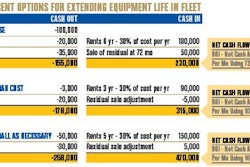
At the 2016 National Pavement Maintenance Expo two sessions were dedicated to job costing, two were dedicated to pricing, and no less than that many touched on one or both of those topics. These are perennial topics – and no doubt have had a similar number of sessions in Expo’s past – not because the topics are so scintillating, but because the speakers know the truth: if you don’t know your costs and you don’t know how to price, you’re doomed.
Although the success rate of new businesses isn’t nearly as low as most people think, it’s not all sunshine and buttercups either. According to data provided by the Bureau of Labor Statistics, small businesses have about a 56% chance of making it to five years. On the bright side, that number is better than what it was in 2010 (46%) and even better for the construction industry at that time (36.4%). These statistics also don’t take into account businesses that have successfully exited (i.e. sold without leaving any debt). On the downside, however, it doesn’t define a successful business either. There are degrees of success.
You obviously don’t want your business to become a statistic. Because of that, you’ve probably been to a class on cost accounting or job costing, read some material on value-based pricing, or talked shop with other companies. But it’s a lot to take in and can be overwhelming. Where do you start?
You start with the first problem of every business: breaking even.
Breaking Even
Breaking even answers a simple question, “How much do we need to sell in order to cover all our costs?” Breaking even isn’t a goal, it’s more of a star by which to navigate. Once you know this value you can predict at what point in the year you’ll start making a profit. Will you be enjoying the holidays with your family or hoping for snow to shovel?
The formula for calculating your breakeven point is very simple:
Profit ($0.00) = Sales - Fixed Costs - Variable Costs
Fixed costs are costs which remain constant regardless of how productive your company is. Leases, salaries, and insurance are examples of fixed costs. Variable costs are costs which change depending on how productive you are. Utilities, equipment rental, fuel, hourly labor, and material are variable costs.
As you can see, this “simple formula” isn’t so simple after all.
Gathering the fixed costs will be easiest, so do that first. Variable costs are going to require a little more digging, and because they’re variable you don’t know how much they’re going to be this year. The best thing you can do is look at last year’s costs and make an estimate based on them. To estimate your variable costs start by answering the following questions:
• Is the cost of material expected to increase or decrease?
• Will we need to hire more workers?
• How will the weather affect us this season?
• Are there new competitors in town?
• Are you expecting more or fewer sales this year?
It’s going to take time and effort to figure out your fixed and variable costs, but once you have them, you’ll be able to know where you stand at any point in the season and you can make adjustments as needed.
Once you’ve achieved your breakeven point, do you need to maintain the same markup or could you perhaps lowball a project just to keep a competitor from getting it? Do you need to maintain the same level of work or can you start slowing down (or speeding up?) a bit? Also, consider creating and displaying a chart for your employees, so they can see when that breakeven point is reached. Achieving goals, especially ahead of schedule, can be a huge morale booster.
Moving the Goalposts
You want to reach your breakeven point as quickly as possible because that gives you more time to increase your profits, and there are a number of tactics you can employ to do just that.
Cutting costs. The formula’s pretty simple: when your sales equal your costs, you’ve broken even. Therefore, if you can lower your costs, you’ve just lowered the breakeven point. You know best which costs you can cut, but be cautioned: cutting costs that requires any amount of sacrifice from your employees may have a negative impact on company morale and productivity, and will work against your goals.
Increasing markup. If cutting costs will lower your breakeven point, then it follows that bringing in more money will also reduce the time and effort necessary to reach breakeven. Increasing your effective markup can be a very valuable method of doing this. As a rule of thumb, we’ve found that companies should be winning 35% of bids with new customers and 65% with existing customers. If you’re winning much more than those markers, consider increasing your markup.
Working more. With the paving and pavement maintenance business being what it is, this really isn’t an option. Most companies are already working 70+ hour weeks during the season. However, if you can bring on new work and workers, you may be able to increase productivity without the need to work “more.”
Negotiating lower prices. This coincides with “cutting costs” above. Talk with your vendors to see if they would be willing to cut you a deal. If you’re expecting a greater volume of sales or if you’re willing to use that vendor exclusively, they may be willing to come down in price. If so, this will lower your costs and thus lower your breakeven point.
Forecasting Sales
When I was a kid, my parents and I visited one of my brothers in Boston. We didn’t have GPS back then, and rather than use a map, my father navigated the city by using the John Hancock Tower building as a landmark. Your breakeven point can be viewed as a landmark, and if that’s the case, then your sales forecast is both the speed and direction you’ll take to reach your landmark and beyond.
A sales forecast is a tool your company should be creating each year to better predict the amount of sales it expects to receive each month. The process of creating a sales forecast helps your leadership and sales teams think through and identify potential problems and opportunities facing your company.
Establishing a Starting Point
The first thing you’ll want to do is establish a baseline from which to work. For existing companies, this is going to be your previous year’s sales. For new companies, you’ll need to make some assumptions. Then we can start asking some questions:
• On average, how many new customers do you attract each year?
• How many do you lose?
• What is your average sale?
• Are there any projects you expect to win this year?
• Do you know of customers requiring work this year?
These are just a few of the questions you can be asking. Work with your sales team to really hammer these and others out.
With this a starting point, we can begin making assumptions about the coming year. When making those assumptions, it’s important to really consider the changes and climate your company will be facing. Every year is different, so merely copying your assumptions from the previous year will lead you down a blind path. Take your time; do the work.
With each assumption you make, try to provide both a figure and reasoning for the assumption. If you expect sales to double this year, back it up with more than, “I can just feel it.”
The current market. The first set of assumptions you need to consider reflect the state of the market. Do you expect more or fewer opportunities? Is the market for construction going to expand? Are there new construction projects you might be able to take part in? What about government projects?
Available resources. The next set of assumptions concerns the resources available to you: your staff, capital (i.e. money), and equipment. More workers provides the ability to work more projects or potentially finish jobs quicker, whereas newer equipment can either increase productivity or allow you to offer new services from previous years.
Your services. If you plan on adding or removing services from your current lineup, what are your expectations for that affecting your business? Perhaps you plan to bring line striping in-house rather than outsourcing it, or maybe focusing more on seal coating because of the higher markup.
The state of the competition. Your competition also affects your sales forecast. Have you seen new companies pop up because of the demand for work? Have you seen an increase in marketing and advertising efforts from them? What are you hearing from your workers who still have connections with previous companies?
Your current strategy. The last thing to consider is your current strategy. If you are planning on hiring new sales staff, increasing marketing efforts, changing pricing, or any number of other tactics, consider how these will affect your year.
A simple way to capture all this data is to use a spreadsheet. Break it up into the five categories above, under which you will have three fields: Assumption, Percent Affect, and Reasoning.
[APRIL – place Mullen Assumptions PVM Chart on the same page as the above sentence, thanks]
Why Forecasts Matter
The future is uncertain and therefore every sales forecast is bound to be wrong. If this is the case, why bother creating a sales forecast? The results, in spite of their inaccuracies, are still valuable. But more importantly, it’s the process of planning that brings the real value to your organization. As Dwight D. Eisenhower said, “…plans are useless, but planning is indispensable.”
By going through the exercise of forecasting your sales for the year, you are forced – along with your team – to consider the many problems and opportunities you might not have otherwise considered. In doing so, you will already be prepared if and when those possibilities arise. Not only that, but because of the groundwork laid in your planning you can address unexpected events you hadn’t considered.
While forecasts will always be inaccurate, that doesn’t mean they’re wholly unusable. They still provide guidance, showing you when you should potentially reach your breakeven point and where you will possibly land at the close of the season.
Combining Breakeven and the Forecast
Within five years, 46% of construction business shut their doors; within ten it catapults to 74%. The companies that fail aren’t going out of business due to laziness but due to an inability to consistently exceed their breakeven point. This is in large part because they don’t even know what their breakeven point is. And even if they know their breakeven point they don’t have a plan to reach it, let alone surpass it.
The breakeven point is never a goal but a yearly milestone. While there is nothing magical about this point, at the very least it signals the success of the company for another year. The calculation for determining your breakeven point is even less magical – it’s where sales minus costs equals zero – and yet so many companies still don’t know what theirs is. Do you?
While knowing your breakeven point is good, it’s even better to know when in the year you’ll reach it. A sales forecast will help you predict that as well as how much you might exceed it. It takes work (and humility) to create it, and demands that you communicate both with your staff and your customers. The results, however, will not only show you where you will be at the close of the season, but the planning will enable you to avoid obstacles and take advantage of opportunities as they arise.
Before going on a journey, you make preparations. You plan out the routes you plan to take and ensure you have adequate supplies to reach your goal. It’s common sense, and yet how many of us don’t recognize that we are on a journey with our business? Taking the time to create a forecast and determine your breakeven point is no different from organizing supplies and planning your journey’s route; they’re the preparations you make to reach your journey’s goal.
Samuel Mullen is a freelance writer based in Shawnee, KS. He can be reached at 913-626-9787.










![Lee Boy Facility 2025 17 Use[16]](https://img.forconstructionpros.com/mindful/acbm/workspaces/default/uploads/2025/09/leeboy-facility-2025-17-use16.AbONDzEzbV.jpg?ar=16%3A9&auto=format%2Ccompress&fit=crop&h=135&q=70&w=240)








